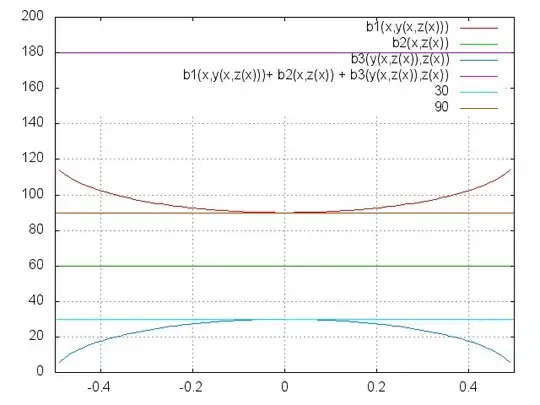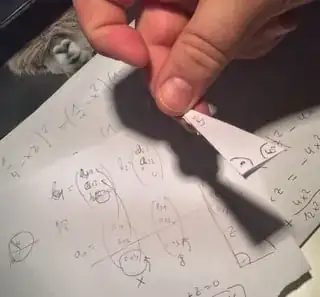Model of the projection
Let the light come from above, along the $z$-axis.
The shadow of an triangle above the $x-y$-plane is then the projection onto the $x-y$-plane ($z = 0$).
The triangle has a unit normal vector $n$ to describe its orientation ($n^2 = 1$).
The shadow projection $P$ is
$$
P =
\left(
\begin{matrix}
1 & 0 & 0 \\
0 & 1 & 0 \\
0 & 0 & 0
\end{matrix}
\right)
\quad
P^c =
\left(
\begin{matrix}
0 & 0 & 0 \\
0 & 0 & 0 \\
0 & 0 & 1
\end{matrix}
\right)
$$
it satisfies $P^2 = P$ and $I = P + P^c$.
Triangle description
We specify the triangle corners by vectors $r_1$, $r_2$, $r_3$ with the origin at $0$.
We define the oriented triangle sides $a_i$ as
$$
a_1 = r_2 - r_1, \quad a_2 = r_3 - r_1, \quad a_3 = r_3 - r_2
$$
The side vectors are linear dependent:
$$
a_1 - a_2 + a_3 = 0
$$

We have the angles $\alpha_i$ at the corner pointed to by $r_i$:
\begin{align}
a_1 \cdot a_2 &= \lVert a_1 \rVert \lVert a_2 \rVert \cos \alpha_1 \\
(-a_1) \cdot a_3 &= \lVert -a_1 \rVert \lVert a_3 \rVert \cos \alpha_2 \quad (*) \\
(-a_2) \cdot (-a_3) &= \lVert -a_2 \rVert \lVert -a_3 \rVert \cos \alpha_3
\end{align}
The equations $(*)$ are still quite general, they just relate the lengths of the sides and the angles, and embody the given orientations of the sides.
Now we get more specific: We use a triangle with these sides and
$$
\lVert a_1 \rVert = 1/2 \quad
\lVert a_2 \rVert = \sqrt{3}/2 \quad
\lVert a_3 \rVert = 1 \quad (**)
$$
and these angles
$$
\alpha_1 = 90^\circ \quad \alpha_2 = 60^\circ \quad \alpha_3 = 30^\circ \\
\cos\alpha_1 = 0 \quad \cos\alpha_2 = 1/2 \quad \cos\alpha_3 = \sqrt{3}/2
$$
This assumes that the scaling of that triangle plays no role, e.g. having all sides twice the length has no qualitative influence on the problem.
To describe the $a_i$ (9 unknowns) in terms of $n$ we have these three equations
$$
a_i \cdot n = 0 \\
$$
plus the three lengths $(**)$ plus the three equations $(*)$ which for this triangle are
\begin{align}
a_1 \cdot a_2 &= 0 \\
a_1 \cdot a_3 &= -1/4 \\
a_2 \cdot a_3 &= 3/4
\end{align}
The Shadow Triangle
The sides of the shadow triangle are $b_i$ and related via the projection:
$$
b_i = P a_i
$$
The projected angles are $\beta_i$ and they should satisfy equations similar to $(*)$:
\begin{align}
b_1 \cdot b_2 &= \lVert b_1 \rVert \lVert b_2 \rVert \cos \beta_1 \\
(-b_1) \cdot b_3 &= \lVert -b_1 \rVert \lVert b_3 \rVert \cos \beta_2 \quad (***) \\
(-b_2) \cdot (-b_3) &= \lVert -b_2 \rVert \lVert -b_3 \rVert \cos \beta_3
\end{align}
We have
$$
b_i \cdot b_j = P a_i \cdot P a_j = a_i \cdot a_j - a_{i3} a_{j3} \\
\lVert b_i \rVert^2 = \lVert P a_i \rVert^2 = \lVert a_i \rVert^2 - a_{i3}^2
$$
Plan: We input our $\beta_i$ into $(***)$ and get three equations for the three unknown $a_{i3}$. From this we try to determine a suitable $n$.
First case $\beta_i = 60^\circ$
The interesting bit is that $\alpha_2 = \beta_2$, which means this angle should stay the same under projection while the other two angles expand or shrink.
Looking at the equation for $\beta_2$:
\begin{align}
(b_1 \cdot b_3)^2
&=
\lVert b_1 \rVert^2 \lVert b_3 \rVert^2 (\cos \beta_2)^2 \iff
\\
\left(\frac{1}{4}+xz\right)^2
&=
\left(\frac{1}{4}-x^2\right)\left(1-z^2\right)\frac{1}{4}
\end{align}
where $x = a_{13}$, $y = a_{23}$ and $z = a_{33}$.
This gives
$$
z = \frac{\sqrt{12} x \sqrt{1- 4 x^2} - 4x}{12x^2 + 1}
$$
plus we know $x - y + z = 0$.
If we have $(x,y,z)$, we can calculate all angles for the projection:
\begin{align}
\beta_1 &= \arccos\frac{-xy}{\sqrt{\frac{1}{4}-x^2}\sqrt{\frac{3}{4}-y^2}} \\
\beta_2 &= \arccos\frac{\frac{1}{4} + x z}{\sqrt{\frac{1}{4}-x^2}\sqrt{1-z^2}} \\
\beta_3 &= \arccos\frac{\frac{3}{4} - y z}{\sqrt{\frac{3}{4}-y^2}\sqrt{1-z^2}}
\end{align}
We get this graph

So while we can keep the projected angle at $\beta_2$ at $60^\circ$, we can not reach $60^\circ$ for $\beta_1$ and $\beta_3$. $\beta_1$ grows from $90^\circ$ and $\beta_2$ shrinks from $30^\circ$.
(At this point I could not resist to rip off a piece from the paper I did the calculations on, and folded a triangle to try it out :-)

(It looked not bad, $\beta_1$ seemed indeed growing)
I am not sure about the other cases, it is easy to make a mistake regarding the solutions, taking the wrong sign etc.
(In progress)


